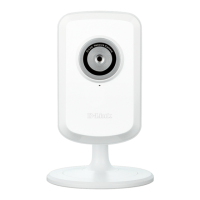57D-Link DCS-930L User Manual
Section 6 - Troubleshooting
5. Why does my DCS-930L work locally but not remotely?
This might be caused by the rewall protection. Check the Internet rewall with your system administrator. The rewall may need to have some
settings changed in order for the network camera to be accessible outside your local LAN. For more information, please refer to the section about
installing your camera behind a router, under “Conguring the DCS-930L without mydlink” on page 48.
Make sure that the network camera isn’t conicting with any Web server you may have running on your network.
The default router setting might be the cause of the problem. Check that the conguration of the router settings allow the network camera to be
accessed outside your local LAN.
6. Why does a series of broad vertical white lines appear throughout the image?
It could be that the CMOS sensor (a square panel situated behind the lens that measures the light signals and changes it into a digital format so
your computer can display it as an image that you are familiar with) has become overloaded when it has been exposed to bright lights such as
direct exposure to sunlight or halogen lights. Relocate the network camera into a more shaded area as soon as possible. Prolonged exposure to
bright lights will damage the CMOS sensor in your camera.
7. The camera is producing noisy images. How can I solve the problem?
The video images may be noisy if the network camera is placed in a very low-light environment.
8. The images appear to be of poor quality. How can I improve the image quality?
Make sure that your computer’s display properties are set to at least 6-bit color. Using 16 or 256 colors on your computer will produce dithering
artifacts in the image, making the image look as if it is of poor quality.
The conguration on the network camera image display may be incorrect. Refer to “Image Setup” on page 33 of the Web conguration section,
which allows you to adjust the related-parameters for improved images, such as brightness, contrast, and saturation control.
9. Why are no images available through the Web browser?
ActiveX might be disabled. If you are viewing the images from Internet Explorer make sure ActiveX has been enabled in the Live Video menu. (Refer
to “Live Video” on page 26.) You may also need to change the security settings on your browser to allow the ActiveX plug-in to be installed.
If you are using Internet Explorer with a version number lower than 6, then you will need to upgrade your Web browser software in order to view
the streaming video transmitted by the network camera.

